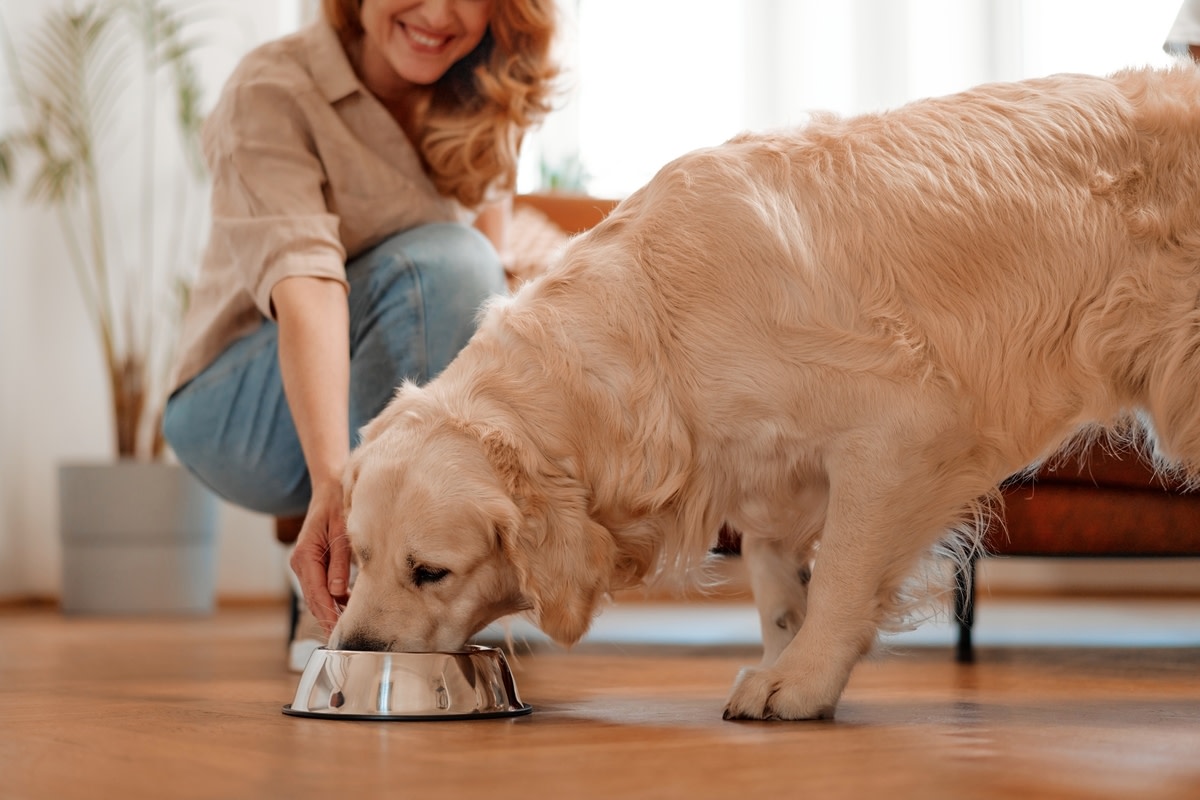
What’s the Best Natural Homemade Food for Dogs With Allergies?
Shutterstock/Orion Production
What Dog Food Should I Feed My Dog with Food Allergies?
My dog was recently allergy (blood) tested and came back with multiple allergies including chicken, potato, sweet potato, rice, wheat, apples, green beans, carrots, corn, peas … all of which he’s been fed n since puppyhood, along with multiple grasses. The reason I had him tested was he was chewing on his feet between the toes. Other than that, he is perfectly healthy, and is a good weight and active. Even though I am not 100% confident in the test results, I changed his diet. But I’m concerned that he’s not getting enough fiber/ vitamins. Also, many dog vitamin supplements contain chicken or shellfish. Do you know of or recommend any particular vitamin supplement? Do you have any suggestions on what I could feed him to replace his kibble? – Katie
Blood Tests Are Not Accurate for Diagnosing Food Allergies
Unfortunately there is no blood test to tell you which foods your dog is allergic to. The tests measure IgE (a type of antibody) in the blood, but even if it’s high, there’s no correlation with an allergic disease. (1) The only way to find out if your dog is allergic to any specific foods, which is what they reported to you from the blood test, is by performing an elimination diet in which he is no longer exposed to those foods. The blood test is only about 15% accurate, so it may be helpful in some cases, but it’s certainly not enough to decide your dog has food allergies. (2)
How Do You Diagnose a Food Allergy in Dogs?
On an elimination diet, you refrain from giving your dogs specific foods for a period of time to see if his symptoms go away. You mentioned giving beef, which is the most common allergen. When a dog is on an elimination diet, he will no longer receive any of the protein sources he has eaten in the past (like chicken, dairy, lamb, soy, and peas). There are some other things like pork, fish, and eggs that dogs can (but rarely) become allergic to, but it is highly unlikely that your dog is allergic to rice, apples, and carrots. The amount of time that your dog will take to stop having any clinical signs will vary, but a food allergy usually takes from 3 weeks to 3 months before it clears up completely.
Signs of Food Allergies in Dogs
There are usually other signs of a food allergy in dogs including:
- Ear infections that sometimes clear up but always come back
- Hair loss and skin infections
- Licking the feet all of the time (There are many causes of this.)
- Scratching the face and head
- Vomiting more than normal
- Loose stools
- Weight loss and poor condition
- No energy, unlikely to run around
- Aggression
If your dog does not have several of those signs and is only licking the feet excessively, it is possible that he simply has grass allergies. Does your dog go out and walk in the grass or in a field? The best way to deal with grass allergies is to wipe the feet and belly after the dog walks outside, or just not let him run around in a field.
If you want to find out if food, and not just the grass, is the problem, you will need to put him on a diet that does not contain the proteins he has been exposed to in the past. There are several options if you want to put your dog on an elimination diet:
- Hydrolyzed commercial diet: This processed diet contains proteins that are broken down so as to not trigger allergies. They are probably similar to the diet you have been giving him, but about 30% of them end up being contaminated by other protein sources from the factory. (3) Another study found that 40% of the dogs fed one hydrolyzed diet with an ingredient they were allergic to developed itching and other problems. (4) They are relatively expensive. I do not recommend these diets, but they work in some cases.
- Minimally processed diet: These diets are available from several sources on the internet and are an alternative if you do not have time to make food at home. You would need to order a food with duck, kangaroo, or some other protein he has never had. There is no data on how many are contaminated with other protein sources.
- Homemade whole food: Making food at home is the only way to be 100% sure of the protein source. It is more work than purchasing dry dog food. Since an elimination diet only needs to be given for a limited time, it is not as important that it be as balanced as a permanent diet.
Transitioning to Normal Food After an Elimination Diet
If the licking is caused by food and not grass allergies, an elimination diet will be more helpful than any blood test. Once the signs are gone (no longer licking his feet excessively) with the elimination diet, you can add back his normal food and see if the signs come back or just continue with the homemade whole food diet that helped clear up the signs. You must ensure the diet is nutritionally complete.
A healthy whole food diet should contain:
- About 10 percent raw bones: Raw chicken bones are safe to swallow and are easily digestible, so you can give necks, carcasses, and wings. If your dog is allergic to chicken and you do not have a source of other bones, you can add the same volume in eggshells to his diet. (If you do not eat enough eggs, you can buy these through the internet.) If you prefer to cook your dog’s food instead of giving raw, do not cook the bones.
- About 50 to 65 percent meat: After the elimination diet is finished, you can continue using the same meat source or introduce alternatives one at a time. I usually use beef sources since they are inexpensive, but you can use any type of meat he is not allergic to.
- About 10 percent organ meats: Some organ meats are important to add vitamins and minerals. If your dog is allergic to beef, you can feed chicken.
- About 10 to 25 percent vegetables: The summer squash you are giving is a great fiber source, but you can also add other sources like carrots. Be sure to blend them so they will be bioavailable to your dog. If the meat portion of this diet is too expensive, you can add whole grains to bulk up the diet, but do not add more than about a fourth of the diet from this category.
- Eggs: An egg contains many of the essential vitamins that may be deficient in the rest of the diet, so I add an egg, including the shell, several times a week. There are no scientific objections to using more egg protein in the diet. If meat is relatively expensive compared to eggs where you live, you can substitute more of the meat portion of the diet with eggs. (You still need to give the bones for calcium and other minerals.) Some veterinary nutritionists feel that the egg white has more protein availability if cooked slightly, but the yolk should be raw so the vitamins are not destroyed. Poached or soft-boiled eggs are the best solutions for that problem.
- Fruit: Most dogs enjoy the sweet taste of fruits, but do not give more than about 5 percent of the diet with these foods.
- Fish: Dogs do much better (skin and joint health) if they are given an omega-3 source in their diet. You can use canned sardines or a fresh fish like mackerel or salmon, but if your dog is allergic to fish, you should give a fish oil supplement.
- Supplements: Besides the omega-3 fatty acid supplement, dogs who are allergic to eggs will need a multi-vitamin supplement.
The numbers above are not exact but should be used as a general guideline. This means you can vary the amounts a bit each day, but try to keep the volumes roughly around those percentages. This food will be better than the kibble you used to give, and you can vary the protein source based on what you find out he is allergic to.
Questions?
If you have any questions about feeding your allergic dog, or any other questions about his or her skin, please send them to my Ask a Vet column and I will be glad to help.
Sources
- Pucheu-Haston CM, Bizikova P, Eisenschenk MN, Santoro D, Nuttall T, Marsella R. Review: The role of antibodies, autoantigens and food allergens in canine atopic dermatitis. Vet Dermatol. 2015 Apr;26(2):115-e30. doi: 10.1111/vde.12201. Epub 2015 Feb 26. PMID: 25728611. https://pubmed.ncbi.nlm.nih.gov/25728611/
- Mueller RS, Olivry T. Critically appraised topic on adverse food reactions of companion animals (4): can we diagnose adverse food reactions in dogs and cats with in vivo or in vitro tests? BMC Vet Res. 2017 Aug 30;13(1):275. doi: 10.1186/s12917-017-1142-0. PMID: 28854915; PMCID: PMC5577833. https://pubmed.ncbi.nlm.nih.gov/28854915/
- Valentine B. “Review of critically appraised topics on adverse food reactions of companion animals.” Can Vet J. 2020 May;61(5):537-539. https://www.ncbi.nlm.nih.gov/pmc/articles/PMC7156131/
- Bizikova P, Olivry T. A randomized, double-blinded crossover trial testing the benefit of two hydrolysed poultry-based commercial diets for dogs with spontaneous pruritic chicken allergy. Vet Dermatol. 2016 Aug;27(4):289-e70. doi: 10.1111/vde.12302. Epub 2016 Jun 16. PMID: 27307314. https://pubmed.ncbi.nlm.nih.gov/27307314/
This article is not meant to substitute for diagnosis, prognosis, treatment, prescription, or formal and individualized advice from your veterinarian. Animals exhibiting signs and symptoms of distress should be seen by a veterinarian immediately.
© 2024 Mark dos Anjos, DVM


